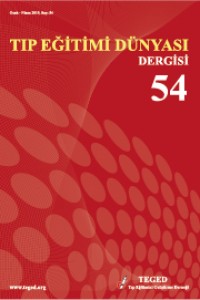Abstract
Ölü
beden, tıp ilminin çok eski çağlardan günümüze geçirmiş olduğu ilerlemede en
önemli bilgi kaynağı olmuştur. Ancak
dinler ve kültürler tarafından ölü bedene kutsal anlamlar yüklendiği için
eğitimde kadavra kullanımı sıkıntılı bir konudur.
Günümüzde
hızla yaygınlaşan ve ülkeler açısından ciddi gelir kalemi olan bir kavram var:
Sağlık Turizmi. Sağlık hizmetinin dünyanın değişik yerlerinde gelişmesi ve
globalleşen dünyada seyahat imkanlarının kolaylaşması ile bu kaliteli sağlık
hizmetine ulaşabilmek için insanlar seyahat etmektedirler. Özellikle ciddi
rahatsızlıklarda ya da uygulanan tıbbi işlemin komplikasyonları neticesinde
hastalar her zaman evlerine şifa ile dönme imkanı bulamayabilmektedirler. Ölüm
durumlarında özellikle uzak mesafeli transferlerde cenazenin çürüme olmadan
transferi önem taşımaktadır.
Eğer
yurtdışından hasta alan hastane yönetimleri konu hakkında bilgilendirilirse bu şekilde vefat eden hastaların uzak
transferlerinin sağlanabilmesi için anatomi bölümlerinde tahnit işlemlerinin
yapılabileceğini düşünüyoruz. Bu yöntemin uygun bir organizasyon ile yetersiz
kadavra bağışı nedeniyle tahnit ve diseksiyon konusunda deneyim sahibi olamayan
akademisyenler için önemli bir eğitim kaynağı olacağına inanıyoruz.
Keywords
References
- Akpolat Y. Ölüm Sosyolojisi’ne Dair: Ölüm İdeolojisi Ya Da Ölümün Toplumsallaştırılması Olarak Eshab-ı Kehf Miti 2013; 51: 121-134.
- Ögcem E. İnsan-Doğa İlişkisinde Ahlaki Bir Neden Olarak Tanrı Faktörü. İnsan ve Toplum Bilimleri Araştırmaları Dergisi 2016; 5(8): 2950-2962.
- Kurt E, Yurdakul SE, Ataç A. An overwiew of the Technologies used for anatomy education in terms of medical history. Procedia – Socialand Behavioral Sciences 2013; 103: 109 – 115.
- Lanska D. The evolution of Vesalius's perspective on Galen's anatomy. History of Medicine 2015; 2(1): 13-26.
- Vanneste, S.F. The Black Death And The Future Of Medicine. 2010. Wayne State University Theses. Paper 29.
- Olry R. Body Snatchers: the Hidden Side of the History of Anatomy. J Int Soc Plastination 1999; Vol 14(2): 6-9.
- Türkiye'de kadavra sorunu ve çözüm önerileri, Türk Anatomi ve Klinik Anatomi Derneği Yönetim Kurulu, 2013.
Abstract
The dead body has been the most important source of information in the progress of medical science throughout history. However, since holy meanings are attributed to the dead body by religions and cultures, the use of cadaver in education is a troublesome issue. Today, there is a concept which has become widespread fast and which has become a serious item of income in terms of countries: Health Tourism. People travel to reach quality health care services because of the improved health services in different parts of the world and the travel opportunities facilitating access to these qualified health services. Especially in serious health problems or as a result of the complications of the medical procedure, patients cannot always return home with a cure. In case of death, especially in transfers including far distance, the transfer of the corpse without decaying is important. If the hospital management, who accepts patients from abroad, are informed about the issue, we think that the embalming procedures can be performed in the anatomy departments in order to transport the patients who died this way to the far places. We believe that with a suitable organization, this method can be an important source of training for academics who cannot have experience of embalming and dissection due to insufficient cadaver donation.
Keywords
References
- Akpolat Y. Ölüm Sosyolojisi’ne Dair: Ölüm İdeolojisi Ya Da Ölümün Toplumsallaştırılması Olarak Eshab-ı Kehf Miti 2013; 51: 121-134.
- Ögcem E. İnsan-Doğa İlişkisinde Ahlaki Bir Neden Olarak Tanrı Faktörü. İnsan ve Toplum Bilimleri Araştırmaları Dergisi 2016; 5(8): 2950-2962.
- Kurt E, Yurdakul SE, Ataç A. An overwiew of the Technologies used for anatomy education in terms of medical history. Procedia – Socialand Behavioral Sciences 2013; 103: 109 – 115.
- Lanska D. The evolution of Vesalius's perspective on Galen's anatomy. History of Medicine 2015; 2(1): 13-26.
- Vanneste, S.F. The Black Death And The Future Of Medicine. 2010. Wayne State University Theses. Paper 29.
- Olry R. Body Snatchers: the Hidden Side of the History of Anatomy. J Int Soc Plastination 1999; Vol 14(2): 6-9.
- Türkiye'de kadavra sorunu ve çözüm önerileri, Türk Anatomi ve Klinik Anatomi Derneği Yönetim Kurulu, 2013.
Details
| Primary Language | Turkish |
|---|---|
| Subjects | Health Care Administration |
| Journal Section | Review |
| Authors | |
| Publication Date | April 30, 2019 |
| Submission Date | September 17, 2018 |
| Published in Issue | Year 2019 Volume: 18 Issue: 54 |


